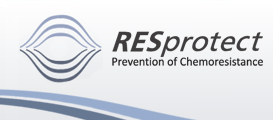|
Page 12 of 12
Acknowledgments
We thank Clemens Dasenbrock (Hannover, Germany) for supervising the in vivo experiments and Volker Rehse (Hannover, Germany) for performing them. Furthermore, we thank Christian Scheler, Proteome Factory (Berlin, Germany) for performance of the two dimensional gel-electrophoresis and protein identification by MALDI-MS.
Footnotes
The costs of publication of this article were defrayed in part by the payment of page charges. This article must therefore be hereby marked advertisement in accordance with 18 U.S.C. Section 1734 solely to indicate this fact.
1 Supported by the "Sächsische Aufbaubank" (Dresden/Germany) Project 6261, and the Fraunhofer-Society (München/Germany).
2 To whom requests for reprints should be addressed, at RESprotect, Fiedlerstr. 34, D-01307 Dresden, Germany. Phone: +493514503201; Fax: +493514503210; E-mail:
This e-mail address is being protected from spam bots, you need JavaScript enabled to view it
This e-mail address is being protected from spam bots, you need JavaScript enabled to view it
3 The abbreviations used are: BVDU, (E)-5-(2-bromovinyl)-2'-deoxyuridine; DOX, doxorubicin; MMC, mitomycin C; MXA, mitoxantrone; MALDI-MS, matrix-assisted laser desorption/ionization mass spectrometry; HOPI, Hoechst 33258/propidium iodide; DMBA, dimethylbenzanthrazene; CGH, comparative genome hybridization; ROS, reactive oxygen species.
4 Two-dimensional gel electrophoresis and MALDI-MS were performed by Proteome Factory (Berlin, Germany, http://www.proteomefactory.com).
5 R. Fahrig, J-C. Heinrich, F. Wilfert, C. Praha, D. Sonntag, unpublished observations.
Received 5/12/03.
Accepted 7/14/03.
References
- Schimke R. T. Gene amplification, drug resistance, and cancer. Cancer Res., 44: 1735-1742, 1984.
- Belinsky M., Jaiswal A. K. NAD(P)H:quinone
oxidoreductase1 (DT-diaphorase) expression in normal and tumor tissues.
Cancer Metastasis Rev., 12: 103-117, 1993.
- Shin H. J., Lee J. S., Hong W. K., Shin D. M. Study
of multidrug resistance (mdr1) gene in non-small-cell lung cancer.
Anticancer Res., 12: 367-370, 1992.
- Fahrig R., Steinkamp-Zucht A. Induction or
suppression of SV40 amplification by genotoxic carcinogens,
non-genotoxic carcinogens or tumor promoters. Mutat. Res., 356: 217-224, 1996.
- Fahrig R. Anti-recombinogenic and convertible
co-mutagenic effects of (E)-5-(2-bromovinyl)-2'-deoxyuridine (BVDU) and
other 5-substituted pyrimidine nucleoside analogs in S. cerevisiae MP1.
Mutat. Res., 372: 133-139, 1996.
- Fahrig R., Steinkamp-Zucht A., Schaefer A.
Prevention of adriamycin-induced mdr1 gene amplification and expression
in mouse leukemia cells by simultaneous treatment with the
anti-recombinogen bromovinyldeoxyuridine. Anticancer Drug Des., 15: 307-312, 2000.
- Bromberg J. F., Wrzeszczynska M. H., Devgan G.,
Zhao Y., Pestell R. G., Albanese C., Darnell J. E., Jr. Stat3 as an
oncogene. Cell, 98: 295-303, 1999.
- Weitzman J. B., Fiette L., Matsuo K., Yaniv M. JunD protects cells from p53-dependent senescence and apoptosis. Mol. Cell, 6: 1109-1119, 2000.
- Wakusawa S., Nakamura S., Miyamoto K. Establishment
by adriamycin exposure of multidrug-resistant rat ascites hepatoma
AH130 cells showing low DT-diaphorase activity and high cross
resistance to mitomycins. Jpn. J. Cancer Res., 88: 88-96, 1997.
- Grusch M., Fritzer-Szekeres M., Fuhrmann G.,
Rosenberger G., Luxbacher C., Elford H. L., Smid K., Peters G. J.,
Szekeres T., Krupitza G. Activation of caspases and induction of
apoptosis by novel ribonucleotide reductase inhibitors amidox and
didox. Exp. Hematol., 29: 623-632, 2001.
- Grusch M., Polgar D., Gfatter S., Leuhuber K.,
Huettenbrenner S., Leisser C., Fuhrmann G., Kassie F., Steinkellner H.,
Smid K., Peters G. J., Jayaram H. N., Klepal W., Szekeres T.,
Knasmuller S., Krupitza G. Maintenance of ATP favours apoptosis over
necrosis triggered by benzamide riboside. Cell Death Differ., 9: 169-178, 2002.
- Russo J., Gusterson B. A., Rogers A. E., Russo I.
H., Wellings S. R., van Zwieten M. J. Comparative study of human and
rat mammary tumorigenesis. Lab. Investig., 62: 244-278, 1990.
- Sambrook J., Russell D. W. Ed. 3 . Molecular Cloning, Vol. 1–3: Cold Spring Harbor Laboratory Press Cold Spring Harbor, New York 2001.
- Pagano M., Draetta G., Jansen-Durr P. Association
of cdk2 kinase with the transcription factor E2F during S phase.
Science (Wash. DC), 255: 1144-1147, 1992.
- Kappler R., Schlegel J., Romanakis K., Mennel H-D., Scherthan H. Comparative genomic in situ
hybridization discloses chromosomal copy number changes in a
transplanted brain tumor line of the rat (Rattus norvegicus). Mamm.
Genome, 9: 193-197, 1998.
- Hodnick W. F., Sartorelli A. C. Measurement of
dicumarol-sensitive NADPH: (menadione-cytochrome c) oxidoreductase
activity results in an artifactual assay of DT-diaphorase in cell
sonicates. Anal. Biochem., 252: 165-168, 1997.
- Haber D. A., Beverley S. M., Kiely M. L., Schimke
R. T. Properties of an altered dihydrofolate reductase encoded by
amplified genes in cultured mouse fibroblasts. J. Biol. Chem., 256: 9501-9510, 1981.
- Desgranges C., Razaka G., D., F., Bricaud H.,
Herdewijn P., de Clercq E. Regeneration of the antiviral drug
(E)-5-(2-bromovinyl)-2'-deoxyuridine in vivo. Nucleic Acids Res., 12: 2081-2090, 1984.
- Kallioniemi A., Kallioniemi O-P., Sudar D.,
Rutovitz D., Gray J. W., Waldman F., Pinkel D. Comparative genomic
hybridization for molecular cytogenetic analysis of solid tumors.
Science (Wash. DC), 258: 818-821, 1992.
- Godbout R., Squire J. Amplification of a DEAD box protein gene in retinoblastoma cell lines. Proc. Natl. Acad. Sci. USA, 90: 7578-7582, 1993.
- Squire J. A., Thorner P. S., Weitzman S., Maggi J.
D., Dirks P., Doyle J., Hale M., Godbout R. Co-amplification of MYCN
and a DEAD box gene (DDX1) in primary neuroblastoma. Oncogene, 10: 1417-1422, 1995.
- Hoege C., Pfander B., Moldovan G. L., Pyrowolakis
G., Jentsch S. RAD6-dependent DNA repair is linked to modification of
PCNA by ubiquitin and SUMO. Nature (Lond.), 419: 135-141, 2002.
- Hofmann R. M., Pickart C. M. Noncanonical
MMS2-encoded ubiquitin-conjugating enzyme functions in assembly of
novel polyubiquitin chains for DNA repair. Cell, 96: 645-653, 1999.
- Fan Z., Beresford P. J., Zhang D., Xu Z., Novina
C. D., Yoshida A., Pommier Y., Lieberman J. Cleaving the oxidative
repair protein Ape1 enhances cell death mediated by granzyme A. Nat.
Immunol., 4: 145-153, 2003.
- Basra J., Wolf C. R., Brown J. R., Patterson L. H.
Evidence for human liver mediated free-radical formation by doxorubicin
and mitozantrone. Anticancer Drug Des., 1: 45-52, 1985.
- Dinkova-Kostova A. T., Talalay P. Persuasive
evidence that quinone reductase type 1 (DT diaphorase) protects cells
against the toxicity of electrophiles and reactive forms of oxygen.
Free Radic. Biol. Med., 29: 231-240, 2000.
- Hamlin J. L., Chi M. The mammalian dihydrofolate reductase locus. Biochim. Biophys. Acta, 1087: 107-125, 1990.
- Kashani-Sabet M., Rossi J. J., Lu Y., Ma J. X.,
Chen J., Miyachi H., Scanlon K. J. Detection of drug resistance in
human tumor by in vitro enzymatic amplification. Cancer Res., 48: 5775-5778, 1988.
- Buettner R., Mora L. B., Jove R. Activated STAT
signaling in human tumors provides novel molecular targets for
therapeutic intervention. Clin. Cancer Res., 8: 945-954, 2002.
- Niu G., Shain K. H., Huang M., Ravi R., Bedi A.,
Dalton W. S., Jove R., Yu H. Overexpression of a dominant-negative
signal transducer and activator of transcription 3 variant in tumor
cells leads to production of soluble factors that induce apoptosis and
cell cycle arrest. Cancer Res., 61: 3276-3280, 2001.
- Geng Y., D’Souza S., Xin H., Walter S., Choubey D.
p202 levels are negatively regulated by serum growth factors. Cell
Growth Differ., 11: 475-483, 2000.
|





